PORSCHE BOXSTER 2005 2.G Owners Manual
Manufacturer: PORSCHE, Model Year: 2005, Model line: BOXSTER, Model: PORSCHE BOXSTER 2005 2.GPages: 276, PDF Size: 4.05 MB
Page 251 of 276
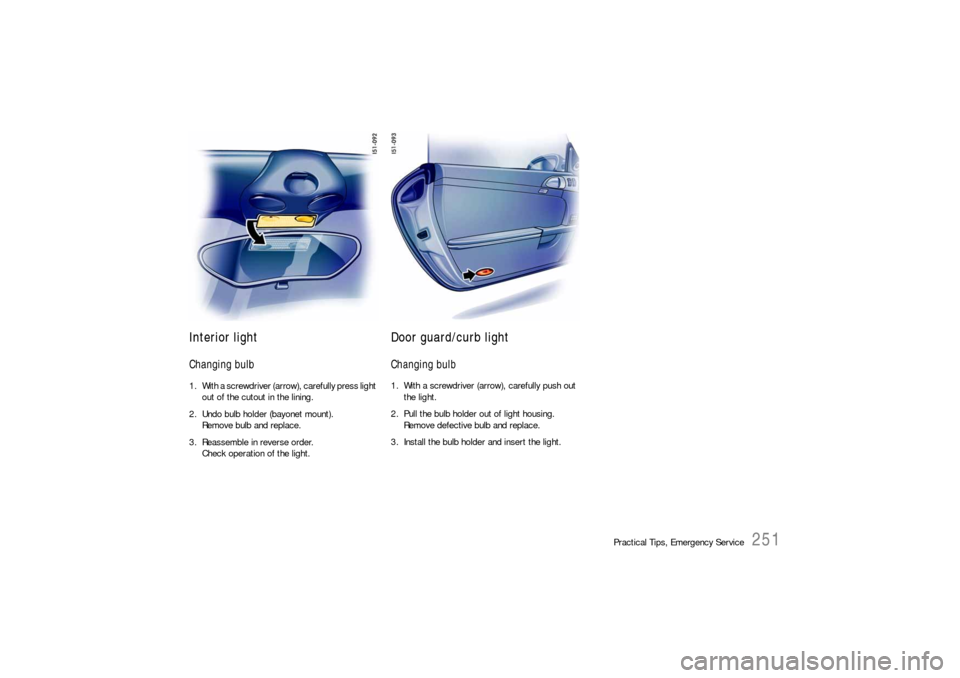
Practical Tips, Emergency Service
251
Interior lightChanging bulb 1. With a screwdriver (arrow), carefully press light
out of the cutout in the lining.
2. Undo bulb holder (bayonet mount).
Remove bulb and replace.
3. Reassemble in reverse order.
Check operation of the light.
Door guard/curb lightChanging bulb 1. With a screwdriver (arrow), carefully push out
the light.
2. Pull the bulb holder out of light housing.
Remove defective bulb and replace.
3. Install the bulb holder and insert the light.
Page 252 of 276
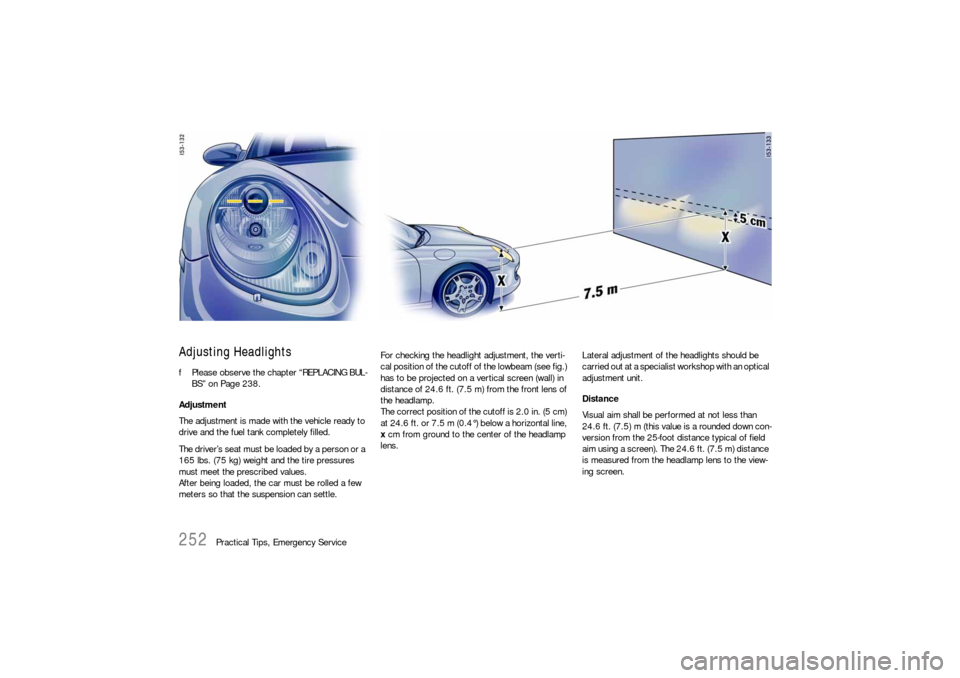
252
Practical Tips, Emergency Service
Adjusting Headlights fPlease observe the chapter “REPLACING BUL-
BS” on Page 238.
Adjustment
The adjustment is made with the vehicle ready to
drive and the fuel tank completely filled.
The driver’s seat must be loaded by a person or a
165 lbs. (75 kg) weight and the tire pressures
must meet the prescribed values.
After being loaded, the car must be rolled a few
meters so that the suspension can settle.
For checking the headlight adjustment, the verti-
cal position of the cutoff of the lowbeam (see fig.)
has to be projected on a vertical screen (wall) in
distance of 24.6 ft. (7.5 m) from the front lens of
the headlamp.
The correct position of the cutoff is 2.0 in. (5 cm)
at 24.6 ft. or 7.5 m (0.4°) below a horizontal line,
x cm from ground to the center of the headlamp
lens. Lateral adjustment of the headlights should be
carried out at a specialist workshop with an optical
adjustment unit.
Distance
Visual aim shall be performed at not less than
24.6 ft. (7.5) m (this value is a rounded down con-
version from the 25-foot distance typical of field
aim using a screen). The 24.6 ft. (7.5 m) distance
is measured from the headlamp lens to the view-
ing screen.
Page 253 of 276
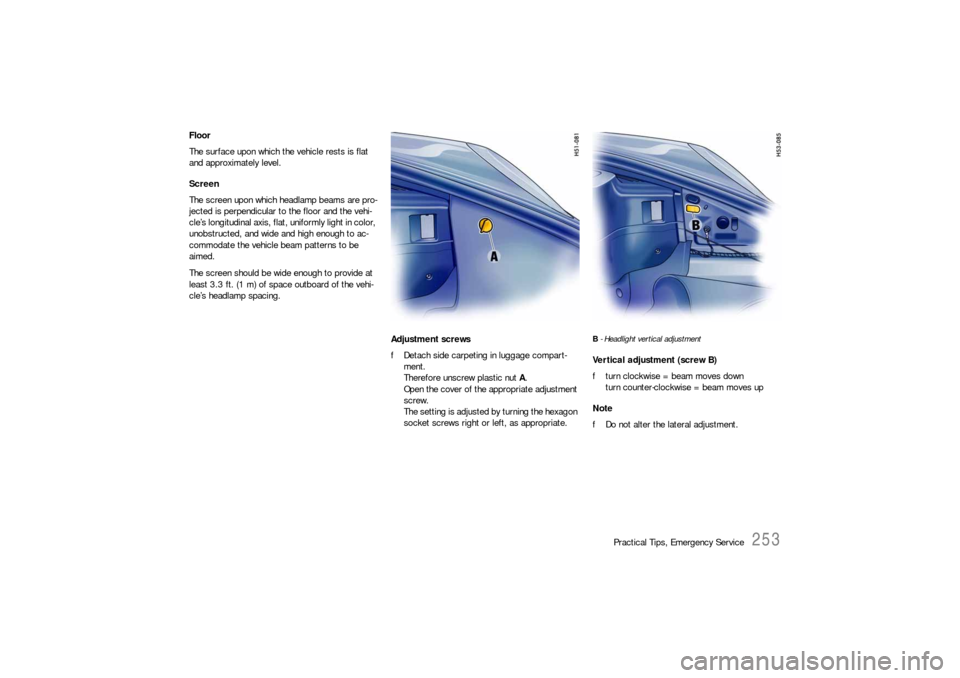
Practical Tips, Emergency Service
253
Floor
The surface upon which the vehicle rests is flat
and approximately level.
Screen
The screen upon which headlamp beams are pro-
jected is perpendicular to the floor and the vehi-
cle’s longitudinal axis, flat, uniformly light in color,
unobstructed, and wide and high enough to ac-
commodate the vehicle beam patterns to be
aimed.
The screen should be wide enough to provide at
least 3.3 ft. (1 m) of space outboard of the vehi-
cle’s headlamp spacing.
Adjustment screws
fDetach side carpeting in luggage compart-
ment.
Therefore unscrew plastic nut A.
Open the cover of the appropriate adjustment
screw.
The setting is adjusted by turning the hexagon
socket screws right or left, as appropriate.
B - Headlight vertical adjustmentVertical adjustment (screw B)
fturn clockwise = beam moves down
turn counter-clockwise = beam moves up
Note
fDo not alter the lateral adjustment.
Page 254 of 276
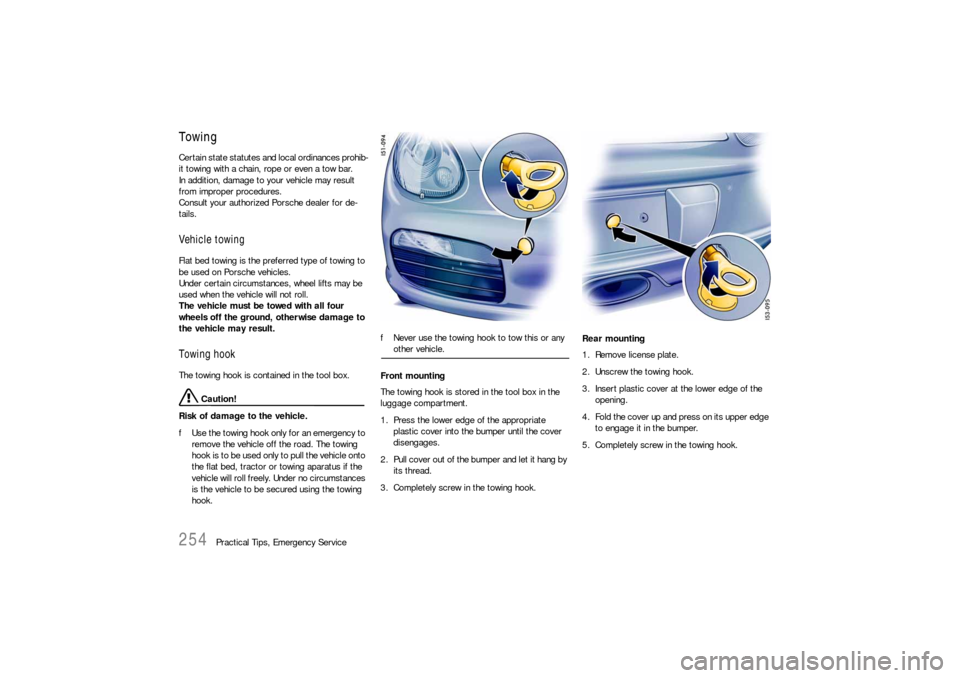
254
Practical Tips, Emergency Service
Towing Certain state statutes and local ordinances prohib-
it towing with a chain, rope or even a tow bar.
In addition, damage to your vehicle may result
from improper procedures.
Consult your authorized Porsche dealer for de-
tails. Vehicle towing Flat bed towing is the preferred type of towing to
be used on Porsche vehicles.
Under certain circumstances, wheel lifts may be
used when the vehicle will not roll.
The vehicle must be towed with all four
wheels off the ground, otherwise damage to
the vehicle may result. Towing hook The towing hook is contained in the tool box.
Caution!
Risk of damage to the vehicle.
fUse the towing hook only for an emergency to
remove the vehicle off the road. The towing
hook is to be used only to pull the vehicle onto
the flat bed, tractor or towing aparatus if the
vehicle will roll freely. Under no circumstances
is the vehicle to be secured using the towing
hook. fNever use the towing hook to tow this or any
other vehicle.
Front mounting
The towing hook is stored in the tool box in the
luggage compartment.
1. Press the lower edge of the appropriate
plastic cover into the bumper until the cover
disengages.
2. Pull cover out of the bumper and let it hang by
its thread.
3. Completely screw in the towing hook.Rear mounting
1. Remove license plate.
2. Unscrew the towing hook.
3. Insert plastic cover at the lower edge of the
opening.
4. Fold the cover up and press on its upper edge
to engage it in the bumper.
5. Completely screw in the towing hook.
Page 255 of 276
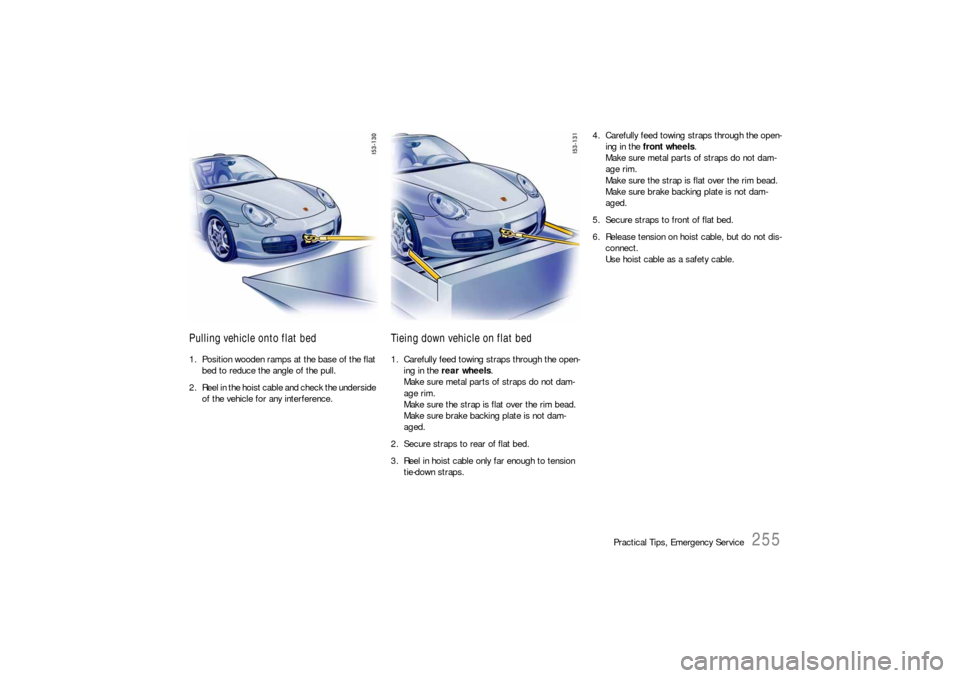
Practical Tips, Emergency Service
255
Pulling vehicle onto flat bed 1. Position wooden ramps at the base of the flat
bed to reduce the angle of the pull.
2. Reel in the hoist cable and check the underside
of the vehicle for any interference.
Tieing down vehicle on flat bed 1. Carefully feed towing straps through the open-
ing in the rear wheels.
Make sure metal parts of straps do not dam-
age rim.
Make sure the strap is flat over the rim bead.
Make sure brake backing plate is not dam-
aged.
2. Secure straps to rear of flat bed.
3. Reel in hoist cable only far enough to tension
tie-down straps. 4. Carefully feed towing straps through the open-
ing in the front wheels.
Make sure metal parts of straps do not dam-
age rim.
Make sure the strap is flat over the rim bead.
Make sure brake backing plate is not dam-
aged.
5. Secure straps to front of flat bed.
6. Release tension on hoist cable, but do not dis-
connect.
Use hoist cable as a safety cable.
Page 256 of 276

256
Practical Tips, Emergency Service
Page 257 of 276

Vehicle Identification, Technical Data
257 Vehicle Identification, Technical Data
Page 258 of 276
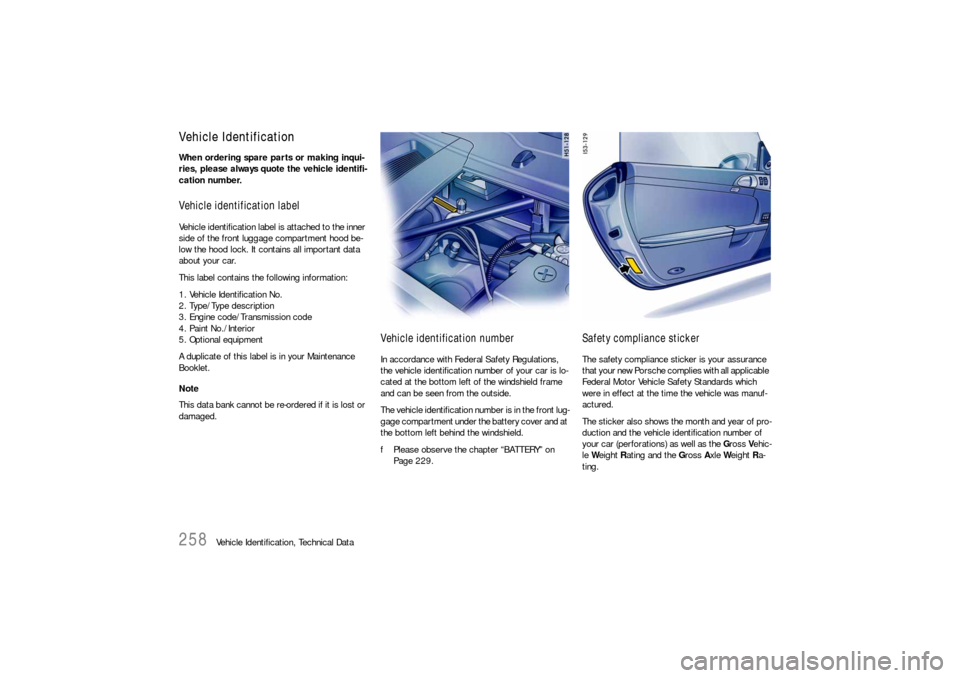
258
Vehicle Identification, Technical Data
Vehicle IdentificationWhen ordering spare parts or making inqui-
ries, please always quote the vehicle identifi-
cation number. Vehicle identification label Vehicle identification label is attached to the inner
side of the front luggage compartment hood be-
low the hood lock. It contains all important data
about your car.
This label contains the following information:
1. Vehicle Identification No.
2. Type/Type description
3. Engine code/Transmission code
4. Paint No./Interior
5. Optional equipment
A duplicate of this label is in your Maintenance
Booklet.
Note
This data bank cannot be re-ordered if it is lost or
damaged.
Vehicle identification number In accordance with Federal Safety Regulations,
the vehicle identification number of your car is lo-
cated at the bottom left of the windshield frame
and can be seen from the outside.
The vehicle identification number is in the front lug-
gage compartment under the battery cover and at
the bottom left behind the windshield.
fPlease observe the chapter “BATTERY” on
Page 229.
Safety compliance sticker The safety compliance sticker is your assurance
that your new Porsche complies with all applicable
Federal Motor Vehicle Safety Standards which
were in effect at the time the vehicle was manuf-
actured.
The sticker also shows the month and year of pro-
duction and the vehicle identification number of
your car (perforations) as well as the Gross Vehic-
le Weight Rating and the Gross Axle Weight Ra-
ting.
Page 259 of 276
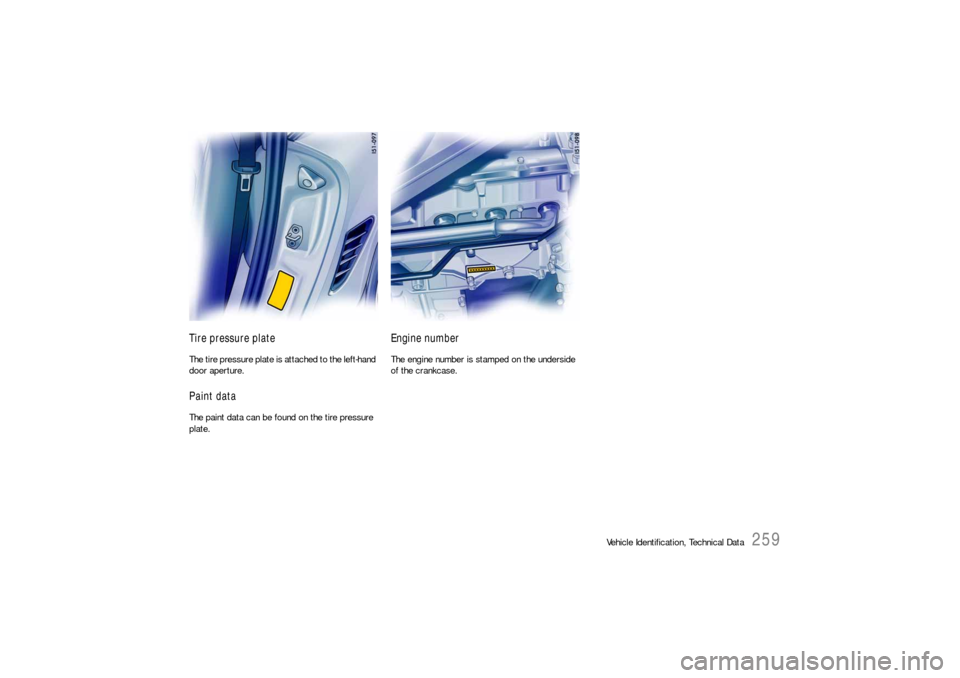
Vehicle Identification, Technical Data
259
Tire pressure plateThe tire pressure plate is attached to the left-hand
door aperture.Paint dataThe paint data can be found on the tire pressure
plate.
Engine number The engine number is stamped on the underside
of the crankcase.
Page 260 of 276

260
Vehicle Identification, Technical Data
Technical DataEngine data
Boxster Boxster S
Ty p e M 9 6 / 2 5 M 9 6 / 2 6
Horizontally opposed engine, liquid cooledHorizontally opposed engine, liquid cooled
Number of cylinders 6 6
Bore 3.37 in./85.5 mm 3.66 in./93 mm
Stroke 3.07 in./78 mm 3.07 in./78 mm
Cubic capacity 163.96 cu. in./2687 cm
3 193.98 cu. in./3179 cm
3
Compression ratio 11.0 : 1 11.0 : 1
Net-horsepower, SAE J 1349 240 hp/176 kW 280 hp/206 kW
at crankshaft speed 6400 rpm 6200 rpm
Net torque, SAE J 1349 199 ft. lb./270 Nm 236 ft. lb./320 Nm
at crankshaft speed 4700 - 6000 rpm 4700 - 6000rpm
Alternator 2100 W 2100 W
Firing order 1 - 6 - 2 - 4 - 3 - 5 1 - 6 - 2 - 4 - 3 - 5
Engine control Stationary high-voltage distribution, sequential injection,
cylinder-selective knock-control, stereo oxygen sensor closed-loop control, diagnostic system,
4 overhead camshafts, Porsche VarioCam, hydraulic valve clearance compensation